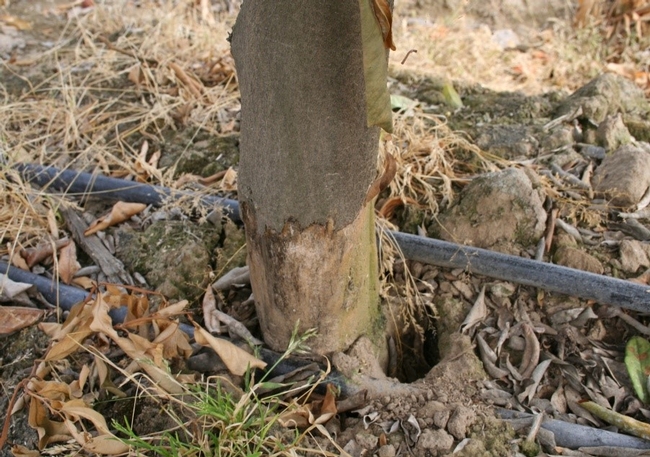
Posts Tagged: voles
Got Voles?
Baldwin and Meinerz are UC Davis and Witmer and Werner are USDA/APHIA/Wildlife Services-National Wildlife Research Center
Voles are short, stocky rodents that often cause extensive girdling damage to a variety of tree and vine crops throughout California. Vole management is often quite challenging given how numerous they can be in a given area. In more recent years, effective management has often relied on some combination of vegetation removal, exclusion using trunk protectors, and rodenticide application. Vegetation removal is a great tool for reducing numbers in a field, but doesn't always eliminate all problems in an area. Plus, vole population size tends to ebb and flow from low to high densities; when densities are high, vegetation removal is often insufficient to reduce girdling damage.
Exclusion through the use of trunk protectors can be a good way to reduce girdling damage as well. However, trunk protectors should be buried at least 6 inches below ground to keep voles from tunneling underneath the protectors. This substantially increases the amount of labor required to protect trees and vines. Ultimately, this approach is only cost effective if high levels of damage are anticipated.
Rodenticide applications are also frequently used to knock down vole populations. However, rodenticide applications are generally not allowable within an orchard or vineyard during the growing season, thereby eliminating the use of one of the most effective vole management tools when it is most needed. Clearly there is room for a new tool to be added to the proverbial IPM toolbox when it comes to managing voles in orchard and vine crops.
Chemical repellents are one such tool that could be considered. Historically, repellents have not proven overly effective for field application against voles. However, recent laboratory testing of anthraquinone indicated that even low concentrations of this chemical were effective at reducing grain consumption by voles. Furthermore, anthraquinone has proven effective as a bird repellent. Anthraquinone is a post-ingestive product that causes animals that consume the product to become ill, thereby making it less likely that the animal will consume the product again during a subsequent feeding event. This kind of repellent is ideally suited for trunk application given that the repellent can easily be applied to the portion likely to be consumed by the vole. If effective, minimal girdling damage should be observed. A repellent application also has the added advantage in that it can easily be paired with vegetation management to hopefully further reduce girdling damage when compared to using either one of these approaches alone. Therefore, we set up a study to test the potential impact that a combination of vegetation management and anthraquinone applications would have on girdling damage by voles to young citrus trees. We also tested the longevity of anthraquinone to determine if long-term repellency following field application was likely. We tested this impact during both spring (characterized by a cool-wet weather pattern) and summer (characterized by a hot-dry weather pattern) seasons to determine if weather impacted potential girdling damage.
We found that anthraquinone was in fact highly repellent following trunk application, with a >90% reduction in girdling damage observed following application regardless of the season when it was applied. Anthraquinone exhibited substantial longevity, with no increase in girdling damage observed for the entire summer (5 weeks) and spring (6 weeks) sampling periods. This clearly indicates substantial repellency for anthraquinone applications, with repellency to last for at least two months, and likely for much longer given that we observed no upward trend at all in girdling damage at the end of our study period.
When combined with anthraquinone treatments, the removal of vegetation completely eliminated all girdling damage during summer. However, we did not observe this same collective impact during spring. That said, the inclusion of vegetation management with anthraquinone applications is likely warranted given our understanding of the need for multiple management strategies to maintain the long-term effectiveness of rodent management programs.
These results clearly indicate effective repellency of voles following anthraquinone applications, but at this time, anthraquinone is not registered for use against any mammalian species. We are hoping to gauge the interest of growers for the registration of this repellent against voles in orchard and vine crops. This is where we need your help. We have developed a very short survey (will take less than 3 minutes to complete) to gauge this interest. Please take this very quick survey to assist in this effort:
https://ucanr.edu/survey/survey.cfm?surveynumber=24480

vole 7
